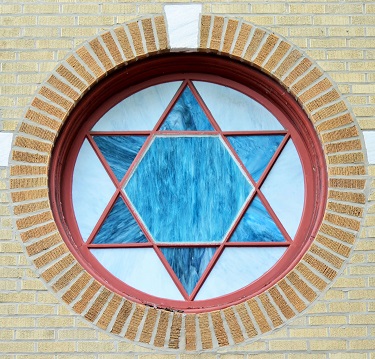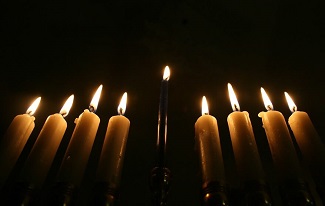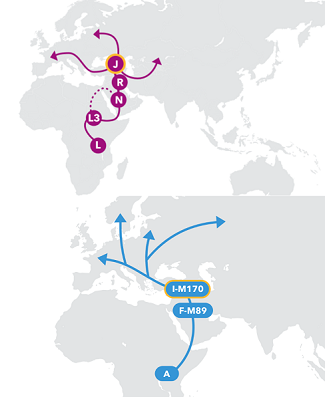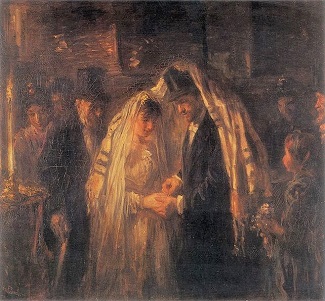
Can DNA Testing Confirm Jewish Ancestry?
You may be wondering if you have any Jewish heritage in your family, or want to confirm family lore about your ancestors being Jewish. There are ancestry DNA tests that can reveal Jewish ancestry, showing the likely percentage of Jewish ancestry in your genetic makeup. Many ancestry services will also match you with genetic relatives in their database, which can be another way to reveal Jewish ancestry. If a large percentage of your genetic relatives have Jewish ancestry, then it’s likely you do too.
Of course, you may know or suspect you have Jewish ancestry, and wonder whether your ancestors were Ashkenazi, Sephardic, Mizrahi, Ethiopian, or Yemenite Jewish, and whether ancestry testing can reveal this. Most ancestry DNA tests will only reveal Ashkenazi Jewish ancestry, since the descendants of other Jewish communities tended to have intermarried more often, and so are more admixed with other ethnicities than Ashkenazi Jews.
So…
What are the different Jewish communities?
If you only suspect you have some Jewish ancestry, but you and your immediate family are not religiously Jewish, then you may not know much about the different Jewish communities and where they migrated to out of the Middle East.
Ashkenazi Jews now make up the majority of the Jewish community in the United States. During the eighth and ninth centuries, they migrated into east and central Europe following waterways and trade routes. People of Ashkenazi origin are often called “European Jews”.

Sephardic Jews belong to a group that migrated to the Iberian Peninsula and flourished during the Middle Ages, until their expulsion from Spain in 1492. Sephardic Jews travelled to the Mediterranean, the Ottoman Empire, North Africa, and even the Americas.
Mizrahi Jews remained in the Middle East, establishing large communities in Iraq, Iran, and Yemen. Today, most Mizrahi Jews reside either in the United States or Israel.
Ethiopian Jews belong to an ancient community dating back more than one thousand five hundred years. Not much is known of their history, since before the 20th century most Ethiopians lived a nomadic lifestyle and relied on oral traditions. In the late 20th century, many Ethiopian Jews migrated to Israel, leaving only a small community behind.
Each community has their own culture and traditions, and they often speak different and multiple languages, though some are falling out of use. Today, the ancestry of many Jews is an admixture of different communities, and many practicing Jews follow traditions historically belonging to different groups.
Testing for Jewish ancestry: autosomal DNA testing and haplogroup testing
When it comes to ancestry DNA testing, most companies only offer autosomal testing. Autosomal tests analyse the DNA in 22 of our 23 pairs of chromosomes, which we inherit from our mother and father in an almost 50:50 split. From our autosomal DNA, we can trace the ethnicities of our ancestors up to ten generations back, but we can’t tell which parent our ethnicities are inherited from, unless we compare genetic results with them.
Traditionally, Jewish heritage is inherited from the mother, though this distinction is becoming less important.
23andMe haplogroup maps
Some companies offer maternal and paternal ancestry testing, which will reveal your male and female haplogroups. Maternal haplogroups are revealed by analysing mitochondrial DNA (mtDNA) which men and women both inherit from their mother. Paternal haplogroup analysis relies on testing the Y-DNA of the Y chromosome, which those born genetically female don’t have. (However, women can still trace their paternal ancestry through certain male relatives. We have published a guide for women who wish to trace their paternal ancestry here. More information about the differences between male and female DNA testing can be found here.)
Maternal and paternal ancestry analysis will trace your mother- and fatherlines, revealing the migratory paths your ancestors took out of or within Africa.
Around 40% of people of Ashkenazi Jewish origin belong to one of four maternal haplogroups: K1a1b1a, K1a9, K2a2a1 and N1b1. Though people of Ashkenazi Jewish ancestry will often belong to a different haplogroup, it is rare for people without Jewish ancestry to belong to one of these maternal lineages – if you do, you can be fairly sure you have some Jewish ancestry.
For paternal haplogroups, it’s estimated that around 35-43% of Jewish men belong to paternal haplogroups J1 and J2, while 15-30% belong to paternal haplogroup E1b1b.
Your mother- and fatherlines are just two lines of your family tree, following your mother’s mother’s mother and your father’s father’s father. You may not belong to any of the haplogroups specifically associated with Jewish origin, and still have significant Jewish ancestry in your family tree.
So, which companies are best for Jewish DNA testing?
There are several ancestry testing companies whose results will reveal Jewish DNA, though in different ways and with different levels of detail.
MyHeritage
MyHeritage offers an autosomal DNA test, along with a family finder feature. While their test doesn’t analyse maternal and paternal haplogroups, it can differentiate Jewish ancestry, and different types of Jewish ancestry.
The different Jewish heritages identified by MyHeritage are: Ashkenazi Jewish, Sephardic Jewish, Mizrahi Jewish, Ethiopian Jewish and Yemenite Jewish.
MyHeritage’s company began in Israel, and so it is unsurprising that their test offers superior detail on Jewish ancestry, as well as different Middle Eastern ethnicities. Though you cannot use their autosomal test to trace migratory routes, you can connect with family members in their database, and take advantage of their family records subscription service, which can help you research your Jewish family history.
23andMe
23andMe’s ancestry DNA test includes both autosomal testing, and maternal and paternal analysis. Their DNA test can reveal Ashkenazi Jewish ancestry, though other Jewish ancestries will likely show up as “Middle Eastern & North African”, or another regional ethnicity. This is because people of Ashkenazi Jewish heritage are historically endogamous (meaning they have tended to marry within their own social group), and so are easier to genetically identify.
Your Jewish heritage may also be indicated by your haplogroup, particularly if you belong to one of the maternal or paternal haplogroups listed above. 23andMe’s haplogroup analysis also produces a map showing your ancestors’ migratory paths.
Connecting with your genetic relatives in the 23andMe database may also suggest Jewish heritage. If a significant number of your relatives have Jewish ancestry, then it is likely you do too.
Family Tree DNA
Family Tree DNA (FTDNA) offers a variety of tests, including autosomal and male and female haplogroup tests. They also offer a family finder feature. Their tests only identify Ashkenazi Jewish ancestry, however they claim to have the largest Jewish customer database in the world, which also contains records from those with Sephardic Jewish ancestry, as well as Levites and Cohanim. If their family finder service matches you to a number of relatives with Jewish ancestry, you can be pretty sure that you also have Jewish ancestry.
Family Tree DNA’s maternal and paternal ancestry tests can identify your haplogroups, which may be one of those specifically associated with Jewish heritage. They will also reveal your ancestors’ migratory paths. Family Tree DNA offers various mitochondrial DNA (mtDNA) tests and Y-DNA tests for identifying maternal and paternal ancestry.
AncestryDNA
AncestryDNA offers an autosomal test and family finder tool. Their test can identify Ashkenazi/European Jewish ancestry, while other sorts of Jewish ancestries may appear as regional ethnicities. They have a database of over ten million users, and so if you wish to discover Jewish relatives and research your family tree, then you are likely to find at least distant cousins in their database.
Their DNA test can be combined with their family records subscription service, which can allow you to trace back your Jewish heritage through your family history. Connecting with cousins will allow you to populate and fill in gaps in your family tree, and work out where exactly your ancestors came from.
GPS Origins
GPS Origins developed their test with researchers that studied the migration of Jewish populations. Of the 500 reference groups used in their analysis, they have included several of known Jewish origin. GPS Origins won’t match you to living relatives, but they will reveal the proportion of your DNA that you share with Jewish populations.
Like Family Tree DNA, GPS Origins can’t differentiate between different Jewish populations, but their test can identify the migratory paths that your paternal and maternal ancestors took after leaving Africa 200,000 years ago. (Please note that although GPS Origins will show both migratory paths, they don’t distinguish which path was taken by your maternal ancestors and which by your paternal ancestors.)
If you have Jewish ancestry, the migratory paths can help you work out which Jewish population you’re descended from, though this is by no means definitive.
Potential issues with testing for Jewish ancestry
As mentioned, most ancestry companies only test for Ashkenazi Jewish heritage, since this community is the easiest to identify using genetic testing. Given the majority of the Jewish community in America is Ashkenazi, they are probably the most well-represented Jewish population in DNA databases, which means that people of Ashkenazi origin are most likely to find relatives and to receive DNA results that reflect their family heritage.

However, since for a long time intermarriage between Ashkenazi Jews and people outside their faith and community was rare, the community has largely been in genetic isolation for several hundred years. This means that people of Ashkenazi heritage are more genetically similar than most populations, and often share stretches of identical or semi-identical DNA even if they are related only very distantly.
For non-Jewish populations, two people that share more than 1.5% of their genetic markers would likely share a relatively recent ancestor. However, in Ashkenazi populations, this 1.5% may actually have been inherited from ancestors that are much farther removed. This means that the statistical inference you can make for non-Jewish populations about how closely related they are cannot be made for Ashkenazi Jewish populations.
If you’re interested in discovering living relatives specifically from the Ashkenazi Jewish population, it’s recommended that you only look at matches where you share more than 2% of your genetic markers with that person.
You can read our guide for finding family members in DNA databases here, or Jennifer Mendelsohn’s guide for working out who your closer Ashkenazi relatives are here.

kevin Martin
10 February 2022
Sorry your information is wrong, autosomnal dna is called entertainment dna and is not taken seriously by any geneticist and its only good for 4 generations, so pointless. Ashkenaz dna sorry the profile that applies to 40% of people that claim to be Jewish is unique, as to the rest of the Jewish world no genetic profile applies nada none. As to My Heritage they use Moroccan for Sephardi, and FT dna use Turkish so total nonsense. It doesnt help thaty some years ago they came up with the Cohen Dna great marketing and as since discovered not qyuite as promised, they obviously forgot to ask Aron for a swab. Seperate to that , the Ashkenaz did not start in the Middle East and go North, by 200 BCE jews were living all over the mediterranean region.. you dont go from 2 small hill tribes in Judea to 10% of the Roman Empire by staying at home.. Ashkenaz or what were to become the Ashkenaz started of in Roman Gaul which became the Carolingian Empite and finally in the 11th century following the massacres of Jews by the 1st Crusade the people started moving eastwards over 100s of years finally in the 1750s a miracle happened a population explosion in Poland where a small population became millions. still to be explained.. but one thing is sure the main 4 founding females were converts not from the middle east , which ofcourse makes sense. As to what were the main components of the Jewish people untill 1750, their genetic profile is no different to any other in their region. As to sephardim we left Iberia 500 years ago and honestly the only Genetic profile I would expect would have been Iberian we lived there for 1700 years we were Iberian no more no less